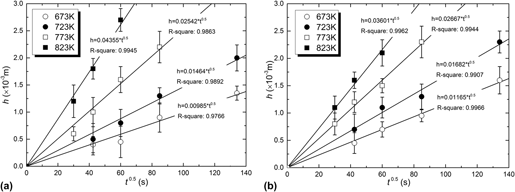Published online by Cambridge University Press: 05 April 2016

The tin–bismuth eutectic alloy possesses anomalous physicochemical properties that are dependent on temperature. This paper reports the interfacial reaction and growth behavior of the intermetallic compound (IMC) layer during the dissolution of solid copper in liquid eutectic tin–bismuth at 673–823 K under the influence of the structural transition of liquid eutectic tin–bismuth. The structural transition markedly affected the dissolution rate constant of solid copper and the growth rate of the IMCs. Correspondingly, the application of the liquid structural transition significantly decreased the activation energy of dissolution and increased the apparent activation energy for IMC growth. Moreover, two major roles of elemental Bi on the formation and growth of the IMCs were suggested.